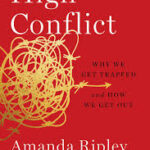
High Conflict
In the early 1980s, Getting to Yes revolutionized the way millions of people thought about conflict.
For good or ill, it has remained the “go to” book for people who want an introduction to our field. While it still is a wonderful book, it does not help–because it cannot–help new readers see how much we have learned in the forty years since it was published.
Amanda Ripley’s High Conflict is going to shove Getting to Yes into second place at least on my list of recommended books for at least two reasons, both of which I’ve dealt with at length in my blog post that takes off on her book.
First, Ripley is one hell of a writer as one would expect of a best selling, award winning journalist. And, she doesn’t ignore the core concepts we academics tend to focus on. She just gets to them as ways of drawing the broader conclusions that emerge from her stories.
Second and more importantly, she walks the reader through three key points that cover pretty much everything I would include in any course I taught:
- high conflict is at best disruptive
- it takes a toll on everyone who has to deal with it, including those of us who make our livings doing so
- the only way out of high conflict involves what she calls complicated the narrative, becoming more curious about relationships, and finding ways to come up with creative as well as cooperative solutions
